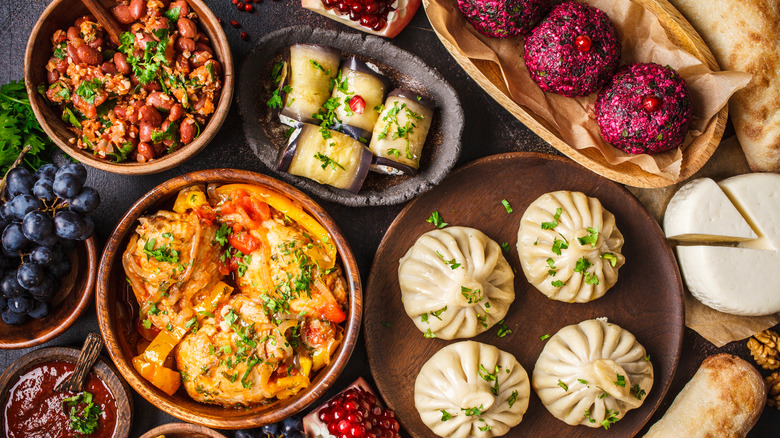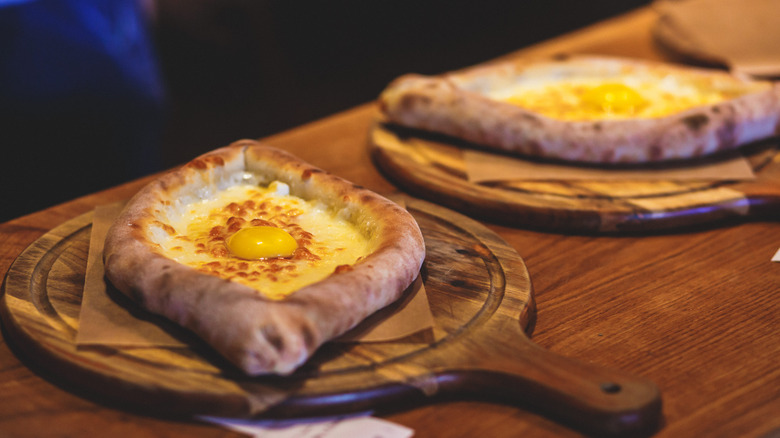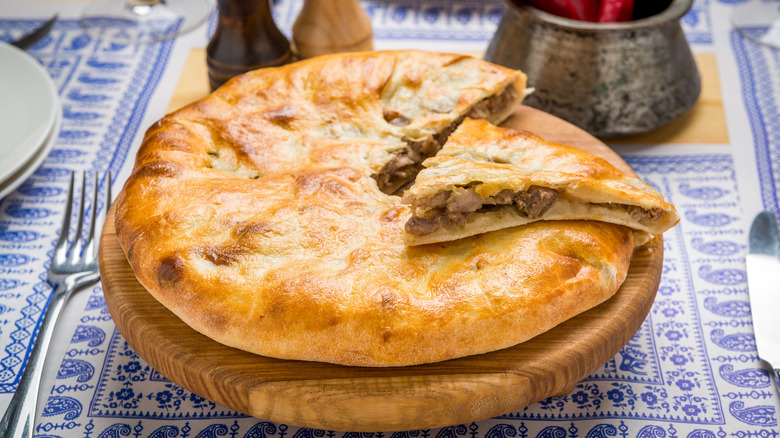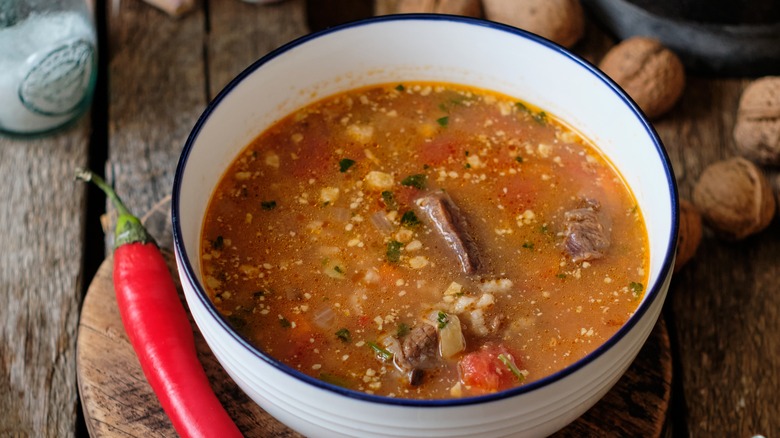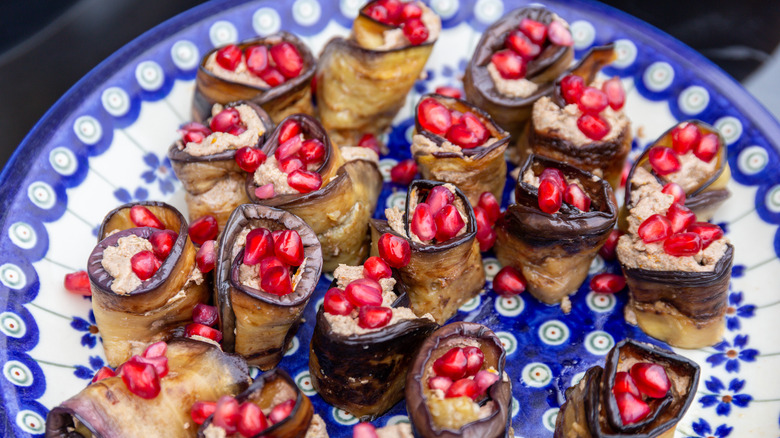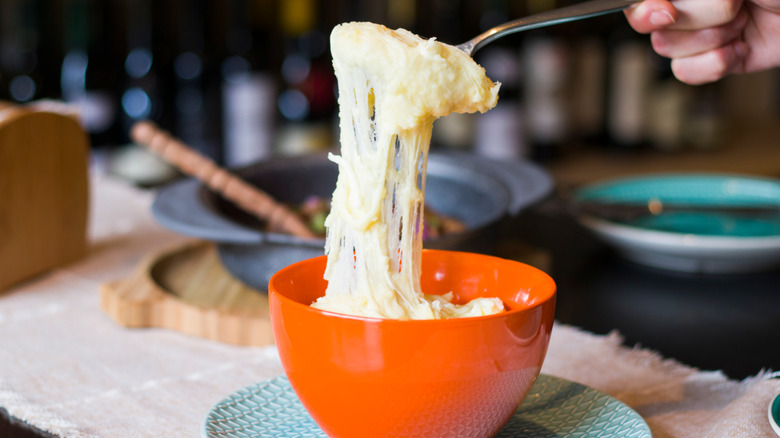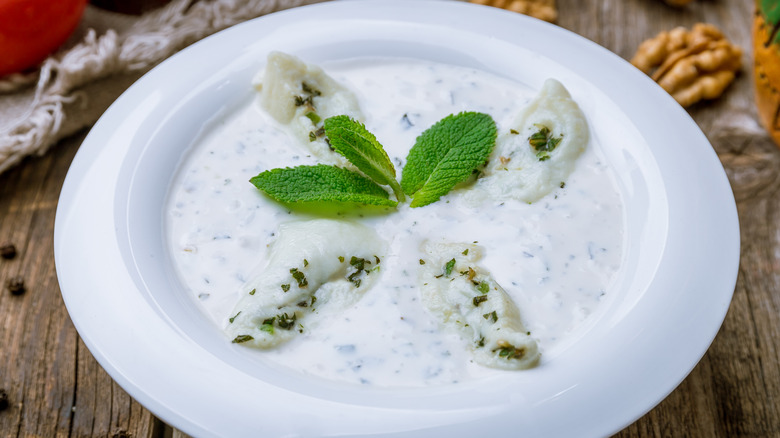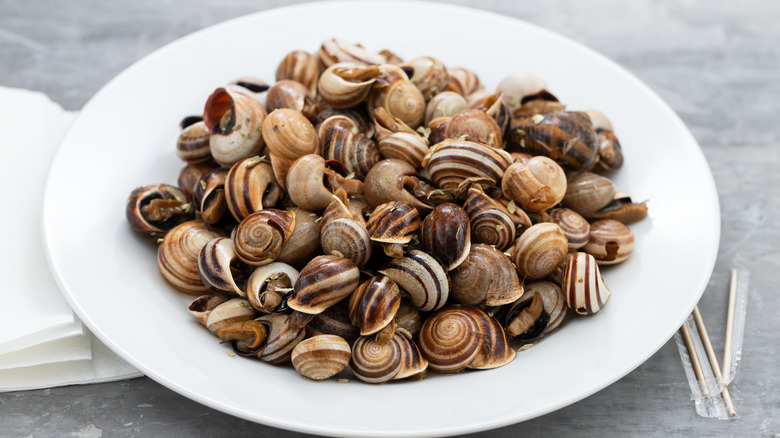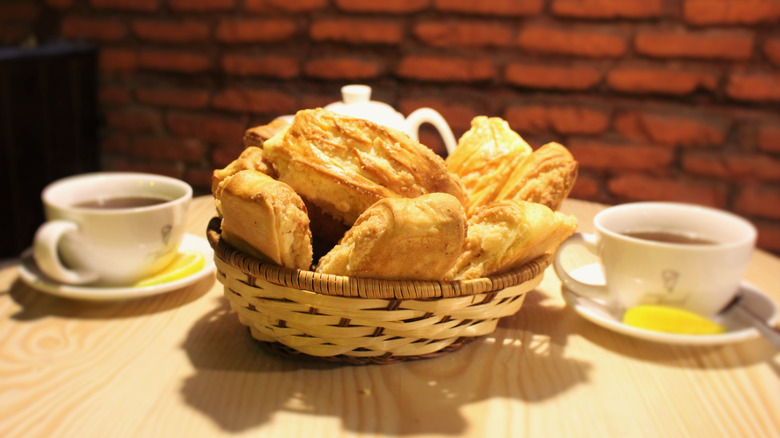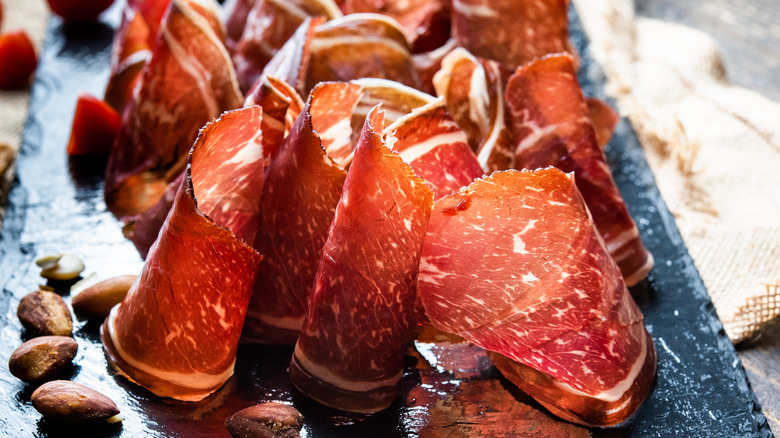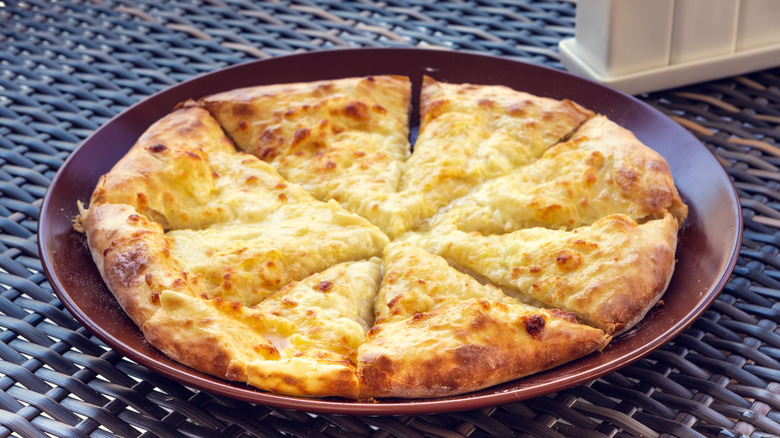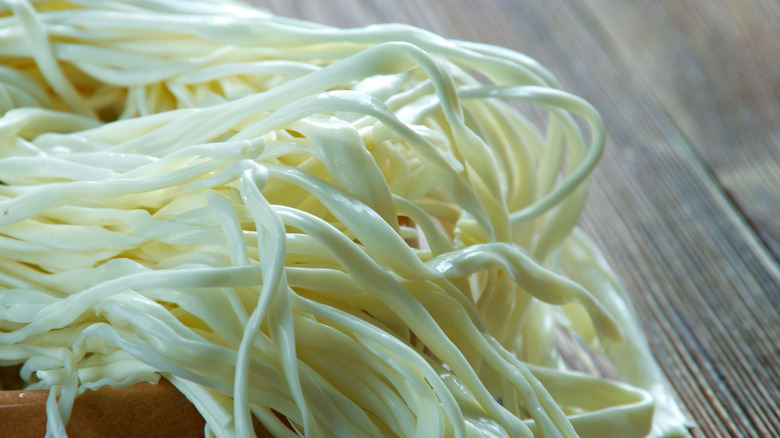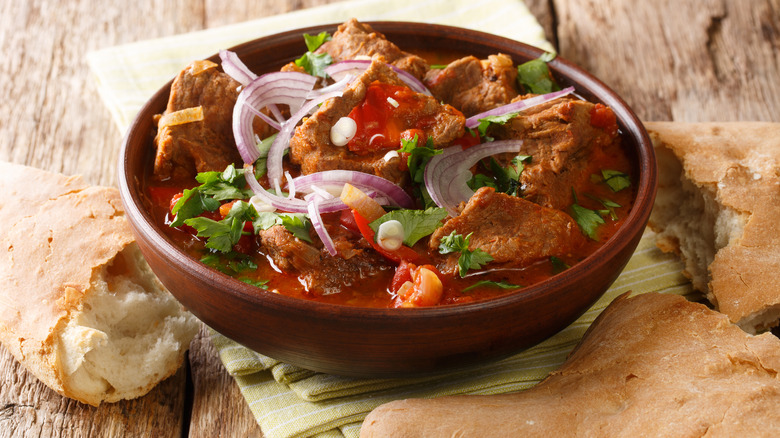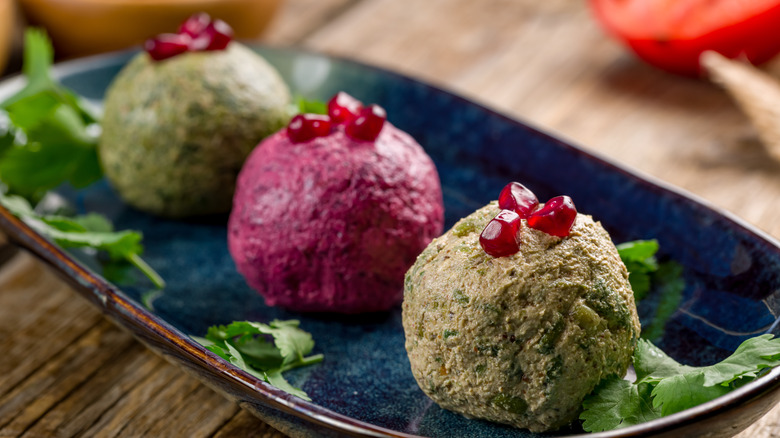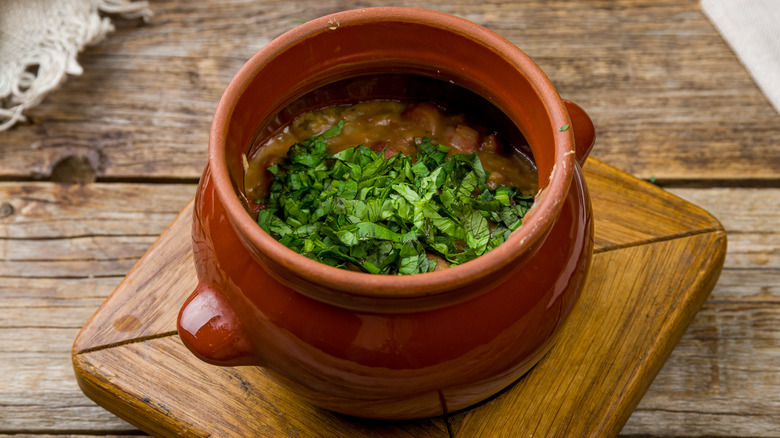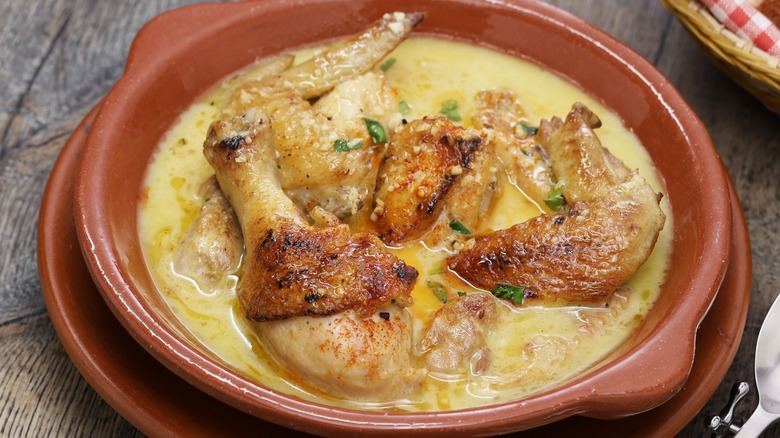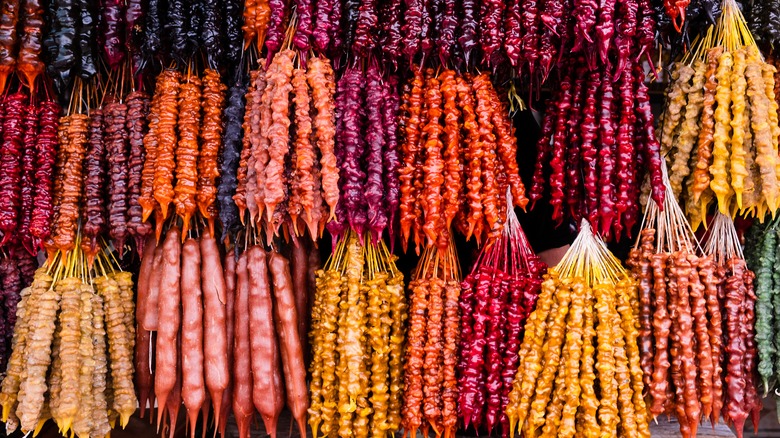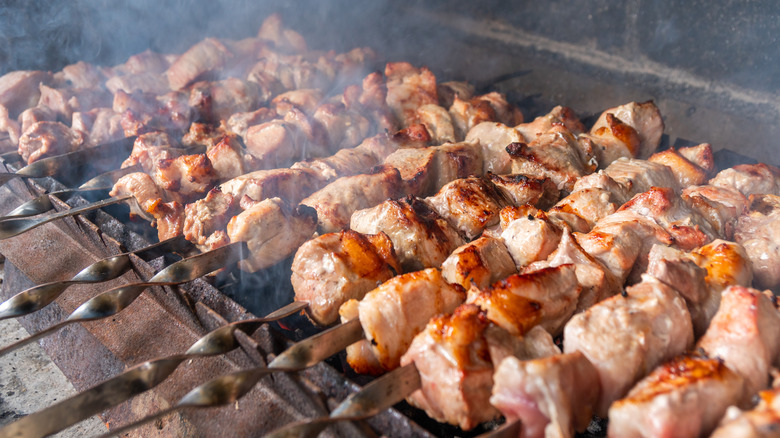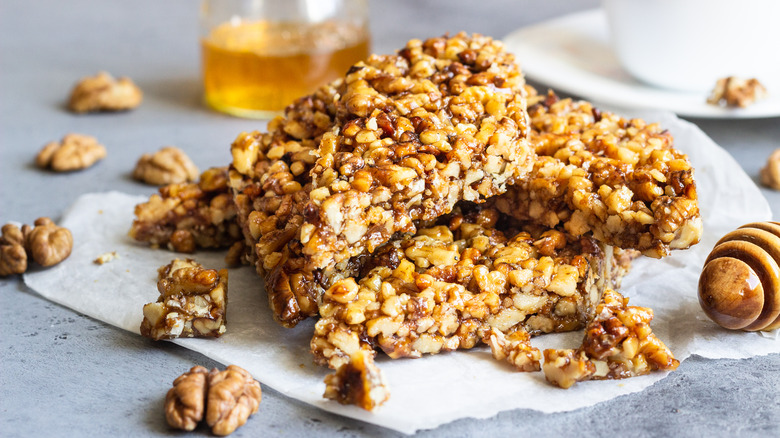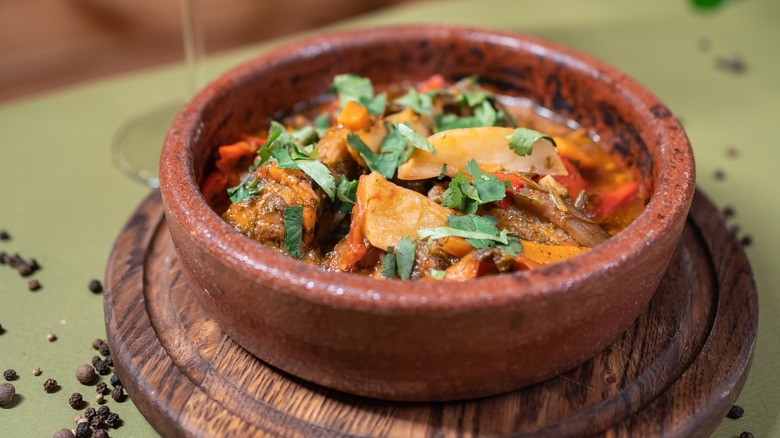20 Authentic Georgian Dishes You Need To Try At Least Once
Food is at the heart of Georgian culture. Hearty beef stews, juicy dumplings, sizzling chunks of barbecued meat, and plenty of cheesy, buttery bread are just a few of the usual suspects found at a supra, a traditional Georgian feast with a cornucopia of traditional dishes to devour. With more than 50 types of khachapuri (a catchall term for stuffed cheese bread), and a whole tapestry of specialty cheeses from classic sulguni to pungent dambalkhacho, Georgian food is worth indulging in for the dairy and carbs alone. But beyond the obvious appeal of bread and cheese, Georgian food is incredibly diverse.
Situated on the Silk Road, Georgia has inevitably been influenced by the cuisine of its neighbors and far-off lands, both of which have helped inspire a unique tapestry of food to feast on. Not only that but as the oldest wine-making country in the world, there are plenty of delicious Georgian wines to accompany your feast. There's also plenty of naturally vegan or vegetarian dishes to choose from — and we aren't talking plain Jane salads — we're talking eggplants smothered in garlicky walnut paste, slow-stewed kidney beans with coriander, and more. Whether you're planning to visit this beautiful little country tucked away in the Caucasus mountains or are planning to visit a Georgian restaurant, these are the dishes you've got to add to your foodie bucket list.
Khinkali
These plump, juicy dumplings are one of Georgia's most ubiquitous dishes. While khinkali are thought to be inspired by Mongols who led conquests through the region in the 13th century, Georgia's spin on a classic dumpling is in a league of its own. Khinkali are typically filled with spiced beef and pork that create a rich, flavorful broth, though there are plenty of other variations, such as mushroom, potato, and cheese fillings.
While the meaty mix can vary by region — kalakuri style, for example, includes the usual base of minced meat, along with onions and herbs — the method of eating remains the same: bite a small hole, slurp out the broth, and chow down. The cute little knob on top? Use it as a handle — no fork necessary.
Adjarian khachapuri
Adjarian khachapuri, or Adjaruli as it's often called, is easily Georgia's most recognizable dish. As the name suggests, Adjarian khachapuri comes from Adjara, a coastal region in western Georgia situated along the Black Sea. While you might assume that seafood is the specialty here, it's actually dairy. The region's lush alpine zones make for perfect pastures that give way to delectable dairy dishes like sinori, borano, and Adjarian khachapuri. The latter of which is a puffy bread boat with a freckled crust filled with a pool of molten cheese topped with an egg yolk and a generous dab of butter.
Simply put, a mouthwatering, show-stopping indulgence. The magic is found in the cheese filling, which is made up of Imeruli and sulguni cheese, two Georgian cheeses whose signature tang and saltiness take this bread boat next level.
Kubdari
Hailing from Svaneti, a highland region in northwest Georgia known for its rugged alpine landscape peppered with hundreds of crumbling medieval towers, kubdari is a stuffed bread loaded with aromatic spices and tender, juicy meat that really hits the spot. The dough for kubdari is typically quite dense and filling, while the meat mixture is usually made up of chunks of veal, pork, or both and seasoned generously with coriander, dill, cumin, and a staple in Georgian cuisine: blue fenugreek.
And though it's an extremely rare find, kubdari is also sometimes made with mountain trout from the region's many rivers. Thanks to its dense, leavened dough and juicy hunks of meat, kubdari is the epitome of a rustic mountain meal — especially when washed down with some stout chacha, a Georgian pomace brandy.
Kharcho
This comforting beef stew originates from Georgia's Samegrelo region but is enjoyed all over the country. While there are many variations, it's generally prepared with hunks of beef that swim in a rich broth of tomatoes, onions, spices, and ground walnuts.
A perfect kharcho starts with browning the beef to create a moisture-locking sear and aromatic base for the stew, while the added flavors of signature Georgian spices, like dried marigold, blue fenugreek, and ground coriander, add even more depth to this much-beloved classic. The real stars of the show, however, are the walnuts that have been ground together with garlic, giving kharcho its signature thick consistency. Kharcho variations include a soupier version served over rice that's sort of reminiscent of gumbo, while others may substitute beef for chicken.
Badrijani Nigvzit
If you've ever found yourself in search of the perfect appetizer, badrijani nigvzit is the answer. Made up of thin slivers of grilled eggplant smothered in a garlicky walnut paste and rolled into cute little pinwheels topped with pomegranate seeds, badrijani nigvzit is one of Georgia's most traditional and beloved bites. Perfectly pop-able and super flavorful, badrijani nigvzit will turn even the strongest skeptics of eggplants into believers.
Once pan-fried, the paper-thin slices of eggplant take on a mild savory flavor that pairs perfectly with the thick schmear of walnut paste enriched with blue fenugreek, coriander, marigold, vinegar, and plenty of garlic. Not to mention the sprinkled pomegranate seeds that give a little spritz of tartness to balance everything out. Best served cold, badrijani nigvzit's flavors continue to develop in the fridge long after it's prepared.
Tashmijabi
Think mashed potatoes are the ultimate side? Just wait until you've tried tashmijabi, an indulgent potato dish from Svaneti. Potatoes were only introduced to Georgia a couple hundred years ago, but tashmijabi with its creamy, buttery texture and ultimate cheesy goodness, makes it seem like Georgia invented the humble root vegetable.
Tashmijabi starts with potatoes that have been boiled, skin-on, before cooling and removing the peels. Afterwards, the potatoes are returned to the stove, where they are given a few glugs of milk and plenty of cheese, and then mashed into a smooth consistency. Because of the copious amount of cheese, tashmijabi creates the ultimate gooey, stringy cheese pull and takes on a slightly salty undertone thanks to the brine. Enjoy it with kubdari for the ultimate Svanetian feast.
Gebzhalia
Originating in Samegrelo, gebzhalia is a Georgian appetizer made with soft cheese and mint. In Megrelian, the local language of Samegrelo, bzha is a homonym for "milk" and "sun," and it's believed that gebzhalia is a sacred dish and was used ritually in ancient times. In other words, gebzhalia is quite literally a dish of the gods.
The key dairy ingredients are milk, fresh sulguni cheese, and nadughi, a softer, subtler version of cottage cheese. The fresh cheese is boiled in milk until it clots into a single form and can be kneaded and flattened into a disc. Then a mixture of mint, garlic, and coriander is mashed with the nadughi, spread across the disc, then rolled and sliced into circles. The remaining milk is then combined with more of the same herbs to create a creamy, minty sauce that the gebzhalia discs are served over.
Lokokina
Enter lokokina, Georgia's answer to escargot. Found in Georgia's southern region of Samtskhe-Javakheti, lokokina is a dish of boiled snails native to the area. It's largely believed that the custom of eating snails can be traced to the presence of French missionaries in the region back in the 16th century.
Traditionally, the snails are simply boiled and served with toothpicks for plucking out their flesh to eat — no need for special escargot tongs here. Modern variations, however, often spruce up the dish with garlic and parsley for an added boost of flavor. While these tasty mollusks may not be the first food to come to mind as a source of protein, they pack quite the punch in minerals and vitamins, such as iron, calcium, and Vitamin A.
Meskhetian kada
Another delight from Georgia's Samtskhe-Javakheti region is Meskhetian kada, a traditional pastry that can be served sweet or savory. Bordering Armenia and Turkey, Meskhetian food — the food native to the Samtskhe-Javakheti region, that is — often presents a few overlaps in food with its neighbors. Kada, for instance, is also enjoyed in its own unique variations in Turkey, Armenia, and Azerbaijan.
Meskhetian kada dough is carefully stretched and folded and traditionally enriched with lard or erbo (traditional enriched butter similar to ghee), though many modern versions will substitute lard for butter. Nonetheless, the end result is equal parts flakey and flavorful. The filling can be salty and savory, best enjoyed with a bowl of hot soup, or it can be sweet and a little nutty, best enjoyed with a stout cup of coffee.
Apokhti
Apokhti is a dried meat dish that is also unique to the Samtskhe-Javakheti region of Georgia. Often compared to jerky, apokhti is made up of salted and sun-dried slivers of goose, duck, or beef and is similar to cecina, a Spanish-cured meat delicacy. Often enjoyed with other charcuterie-esque accompaniments like dried fruits, nuts, and cheeses, apokhti also pairs great with regional wines, such as Mtskhetian Mtsvane, a dry white, or a classic bold saperavi.
While apokhti's tang and saltiness make it great for charcuterie boards and other finger foods, another tasty (and more filling) way to consume it is in khinkali. Apokhti khinkali, made with goose, is a Meskhetian mainstay and is often served with a dollop of sour cream and crispy onions.
Imeretian Khachapuri
The country is home to more than 50 types of khachapuri, a catchall term for cheese-filled bread. Imeretian khachapuri, which hails from the west-central region of the same name, Imereti, is among the most popular of these.
Imeretian khachapuri is a stuffed, yeasted disc of dough that is filled with fresh, fatty Imeruli cheese and baked on a clay pan called a ketsi. Once the dough is prepared, it's flattened into a disc and piled high with Imeruli cheese. Then, the dough is pinched up at the sides to close a ball around the cheese so that it can be rolled out and flattened. Traditionally, this is when the khachapuri would be placed on the ketsi and put in the fireplace to bake. However, many modern variations opt for a stovetop. The end result is the same: cheesy, buttery goodness.
Tenili Cheese
Home to both the Samtskhe-Javakheti and Kvemo-Kartli regions of Georgia, Tenili is a special type of Georgian cheese that is hand-pulled and stretched to create tangled piles of salty, sour string cheese. The process of making tenili is both laborious and fascinating.
First, cow's or sheep's milk is boiled over a fire to divide the curds from the whey; once the curds have coalesced into a glump, they are removed from the whey and placed in a separate container. Then, the magic begins. The ball of curds is carefully stretched by hand as hot liquid is poured over them, and as the curds continue to be 'pulled,' the string cheese begins to form. Afterward, the tenili is stuffed into clay pots filled with sour cream (tenili means 'something that is overstuffed'), where they will be preserved.
Ostri
Ostri is a richly spiced, slow-cooked beef stew that doubles as the ultimate comfort food. Hunks of beef chuck are boiled with bay leaves that help the meat retain its tenderness while also adding flavor before garlic, onions, and herbs are added. Once the meat has had plenty of time to simmer on the stove, tomatoes and ajika — a spicy chili paste from western Georgia — are added to the mix.
Some variations include adding chopped pickled cucumbers or khmeli suneli, a Georgian five-spice blend of coriander, blue fenugreek, dill, marigold, bay leaves, and summer savory. Ostri is served piping hot and is best slopped up with a few slices of Imeruli khachapuri or a pillowy piece of shotis puri, a traditional Georgian bread baked in a clay oven known as a tone.
Pkhali
Don't worry; Georgian food is not all beefy stews and cheese bread — for something a little lighter, there's pkhali. These colorful balls are made up of walnut paste that has been mashed together with a vegetable, usually spinach, beets, or carrots, to make a sort of vegetable pâte.
Every phkali starts with a cooked vegetable. In the case of spinach, it's chopped, then boiled on the stove for a few minutes, strained, and squeezed dry. The binder, a.k.a. the walnut paste, comes together with ground walnuts, pomegranate juice, garlic, coriander, and crushed red pepper flakes. Finally, the spinach and walnut paste are mixed together and shaped into tiny, mandarin-sized balls and topped with pomegranate seeds. To eat the pkhali, simply enjoy it on its own, or use a schmear of it over mchadi, a crispy Georgian cornbread.
Lobio
This humble bean stew originates in the western Georgia area of Racha, is loaded with fenugreek, cilantro, onions, and walnuts, and is simmered low and slow to create the ultimate hearty dish. Lobio is Georgian for the stew's main ingredient: 'bean' and is often enjoyed with mchadi and a spread of pickled vegetables such as pickled peppers, cabbage, and bladdernut buds known as jonjoli.
Lobio is made with kidney beans, has simple ingredients, and is a straightforward preparation. The beans are stewed with a base of fried onions and a paste made from dried coriander, blue fenugreek, garlic, walnuts, and cilantro. Once the concoction has had plenty of time to simmer on the stove, the lobio is served in petite clay pots perfect for enjoying on its own or with a spread of other delights like khachapuri or khinkali.
Shkmeruli
This uber creamy, super garlicky chicken dish also comes from Racha, and is a favorite of locals and visitors alike. It's such a signature dish, in fact, that it made an appearance on Anthony Bourdain's "Parts Unknown" during his 2016 visit to the country's capital, Tbilisi. Loaded up with milk and no less than two heads of garlic, shkmeruli is easy to love and even easier to devour.
It starts with a whole chicken that has been butchered into eight pieces. The chicken is slightly browned before it simmers in a rich, creamy sauce comprised of garlic, milk, and oftentimes, heavy cream or sour cream. Traditionally, shkmeruli is cooked and served in a ketsi. It is best enjoyed with a refreshing glass of rkatsiteli, a much-beloved white wine, while its garlicky juices can be soaked up with a warm hunk of shotis puri.
Churchkhela
Appearing more candlestick than dessert, churchkhela is a Georgian sweet made with nuts and concentrated grape juice. While Georgia isn't exactly known for its sweet treats, it is known for its grapes — ahem, its wine.
Churchkhela comes together by threading walnuts, or sometimes hazelnuts, onto a string. Meanwhile, concentrated grape juice and flour come together to make a roux-like mixture that the string of nuts will be dipped into before they are left to dry. Churchkhela naturally has a long shelf life, and as far as desserts are concerned, it's pretty healthy; plus, the walnuts are an excellent source of protein and fiber. For both of these reasons, once upon a time, churchkhela was a frequent snack of soldiers – think of it like a Georgian MRE. To eat the churchkhela, simply tear off a bite or slice it into tiny discs.
Mtsvadi
Who doesn't love a good barbecue? With so many different types of barbecue around the world, it can be hard to pick a winner, but in our opinion, mtsvadi comes pretty close. Not unlike souvlaki in Greece, khorovats in Armenia, and the many shashliks and shish kebabs of Russia and Turkey, mtsvadi is made with skewered hunks of meat.
It is typically made from pork, though sometimes veal, mutton, or chicken are used, and is marinated in a sloppy mix of onions, khmeli suneli, and wine or pomegranate juice. Once the meat is finished marinating, it's skewered and placed over embers and dried grape vines until it cooks to a smoky, juicy perfection. While mtsvadi is a star dish on its own, it's also delicious when dipped into tkemali, a sour, tangy sauce made from plums.
Gozinaki
No holiday season in Georgia is complete without plenty of gozinaki — a simple treat that combines just two ingredients: honey and walnuts. Sort of a cross between a bark and a nougat, somewhere between classic peanut brittle and Spain's much-beloved turron, gozinaki is a confectionary treat of candied nuts.
Chopped walnuts are carefully caramelized with honey on the stove until they begin to transform into a semi-hard candy mixture. Afterward, the sticky, gooey, nutty mix is spread on a tray and cut into little diamond pieces. Gozinaki is a popular treat throughout the holiday season — especially on New Year for a sweet coming year — but can be enjoyed year-round. Occasionally gozinaki can be found with almonds or hazelnuts, but walnuts are the traditional nut of choice.
Ajapsandali
Badrijani nigvzit isn't the only use of eggplant in Georgian cuisine — there's also ajapsandali, a chunky vegetable stew that is typically served chilled. Like many other Georgian dishes, it varies a bit from region to region — spicer in the west, oilier in the east — but its foundation remains the same.
It starts with eggplant simmering on the stove until its bitterness transforms into a sweet, soft, and slightly smoky concoction perfect for ajapsandali's base. The rest of the stew is comprised of browned onions and garlic, cubed potatoes, juicy tomatoes, zesty bell peppers, and tons of herbs and spices that typically include cilantro, parsley, basil, ground coriander, bay leaves, and crushed red pepper. While it's often served cold, it's also delicious when it's still warm.
